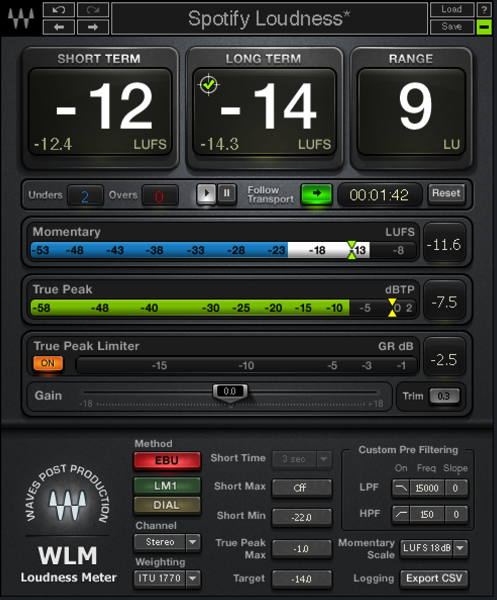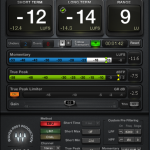
What’s LUFS Got to Do With It? – Part 2
Last time out I talked a bit about loudness metering and why it’s a good thing. Now let’s get into some specifics because these meters are a little different than the simple metering we’re probably all used to in our consoles, DAW’s, and plug-ins.
Most loudness meters display four things: Momentary Loudness, Short-Term Loudness, Integrated or Long-Term Loudness, and Loudness Range.
Momentary loudness is what your signal is doing right now. It is an un-gated measurement with a time constant of 400ms which puts its ballistics pretty close to an RMS or VU style of metering.
Short-Term Loudness is a measurement over a slightly longer period of time. In most cases, Short-Term will be an average of the last 3 seconds of audio, although, some meters will let you modify this.
Integrated Loudness and Long-Term Loudness are exactly the same thing; it just depends on what the manufacturer decided to call them. They look at an average over the entire length of the content. In some measurement modes, this measurement will be a gated measurement that rejects all content lower than 8 dB below the target loudness.
Integrated Loudness is the Big Daddy measurement you’re going to need to pay attention to if you ever need to meet a specific delivery specification. It’s also the measurement you’ll want to use if you’re trying to get your content consistent.
Finally, the Loudness Range tells us the range of our program from the quietest short-term loudness to the loudest short-term loudness. It’s my understanding that in some meters the Loudness Range or LRA measurement removes the loudest 5% and lowest 10% of the total range in order to exclude any extremes from the measurement.
Now, let’s get practical. The first thing you’re going to want to do is establish a target Integrated Loudness. The American broadcasting standard is -24 LKFS as outlined in ATSC A85/13. The European standard is -23 LUFS. YouTube and Spotify employ loudness normalization to bring their content to -14 LUFS. iTunes soundcheck and Apple Music use -16 LUFS for loudness normalization. And finally we have the AES streaming recommendation of -16 LUFS. So much for standards, right? So why are these target levels all over the place?
The broadcast standard of -24 LKFS is there to allow for a lot of headroom in programming. This way something like a gunshot in a TV show can maintain its full dynamic impact because there is plenty of headroom for the peak transient of the sound effect. The downside to this, though, is the resulting long-term signal level is often too low for headphone amplifiers in portable audio equipment. The available dynamic range may also run contrary to the environments where things are being listened to. Lots of dynamic range is great when you’re in a cinema or in the quiet comfort of your living room, but not so good if you’re showing a video to a friend in a restaurant or listening to music while racing down the freeway.
If you are doing any kind of programming for a television network, my recommendation is to use -24 LKFS as your initial target. I’ve been using -24 LKFS as a target for several years now because when I’m working in my studio I work on a range of content from music production to audio post-production, and my monitors are calibrated for me to naturally mix right to that level within a couple dB which would fulfill the delivery specs for most networks. It also allows me a plenty of headroom so I can mix music with better dynamics. When I need to deliver material for a higher level, I use a limiter to bring my material up in level to meet the delivery spec.
Now this brings up a good point because I was originally turned on to using a calibrated monitor level by Bob Katz and wrote a bit about this several years ago. These days my monitors are calibrated more along the lines of the ATSC recommendations, and I’ve tweaked the level a bit over the last couple of years to personalize it for me. As I mentioned years back, the idea of using calibrated monitors is you can just mix without needing to constantly reference a meter, and I find this especially helpful when working with loudness specs.
If you’re going to implement loudness standards, I highly recommend calibrating your monitors as it’s not that hard to do and makes things easier in the end. Check out ATSC A85:2013 to get an idea of how to do this and what level to calibrate your monitors to. I like the ATSC guide because it lists different levels to use depending on the size of your room. My mix room isn’t tiny, but it is less than 1500 cubic feet so I use a much lower calibration level for my monitors than I used to use in the larger studio I mixed in at North Point.
If you’re not going to do anything for network television at any point in time and the majority of your content will be for streaming, my recommendation is to use -16 LUFS +/- 2dB as your target with a True Peak of -3 dBFS. This way you still have decent room for dynamic range, but you’ll be delivering more in line with the streaming services. Right now YouTube and Spotify normalize to -14 LUFS, but I wouldn’t be surprised if in the next few years they move to -16 LUFS which is in line with the AES streaming recommendation.
One place I differ from AES, though, is on the True Peak level. The True Peak level is the absolute loudest the audio signal level will ever get after digital to analog conversion. This is a little different from just a peak level on your digital peak meter because the True Peak level will account for inter-sample peaks which are peaks that may arise as part of the digital to audio conversion. An inter-sample peak won’t clip the digital peak meter internally, but it may clip the audio converters resulting in audible distortion.
I suggest using -3 dBFS for your True Peaks right now because if you are moving content mixed to -16 LUFS to a service like YouTube, the loudness normalization will bring your mix up 2 dB to meet their specs. Since they’ll be using a -1 dBFS True Peak, you will stay away from any limiting they might employ as part of their loudness normalization. In other words, they’ll theoretically just turn your content up. Now, this isn’t going to make an enormous difference so I wouldn’t stress about this, and if you want to just use -1 for True Peaks you’re probably going to be fine. I just know I personally feel better when I have a good idea of what things are going to sound like before I deliver them.
In the next article, I’ll talk about a practical approach for using a loudness meter while mixing.


 Previous Post
Previous Post


